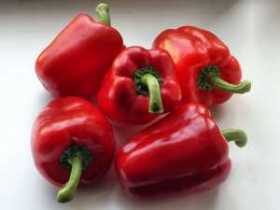How to Grow Sweet Peppers – A Guide to Growing Sweet Peppers
 Sweet Peppers
Sweet Peppers
Capsicum is another name for both sweet, bell-shaped peppers and hot chilli peppers. In the UK, sweet peppers are normally a greenhouse crop although in a good summer it is possible to grow them outdoors or in pots.
Varieties of Pepper
- A particular favourite sweet pepper is Gypsy F1.
- Smaller varieties, suitable for pot growing, include Redskin, Gourmet (an RHS Award of Garden Merit holder), Mohawk, Sweet Ingrid, Roberta, Barancio, Peperone Cuneo Giallo, Mini Bell.
Pests and Problems
- If watered irregularly, peppers can suffer with blossom end rot.
- The main pests are aphids and red spidermites. Effective biological controls are available for both. Misting the plants with water helps to deter the spidermites.
Sowing and Growing
- Start seeds under heat in late February–March.
- Transfer the seedlings to 8 cm (3 inch) pots when large enough to handle, and then into 15 cm (6 inch) pots before moving them to their final home.
- Peppers can be grown in growbags, 8-10 inch (20-25 cm) pots, or the greenhouse border.
- The plants are cold sensitive so select a warm, sheltered area for them.
- Staking growbag and border plants is recommended as they can reach 60 cm (3 feet) and fruit weight could damage the stalks.
- To encourage fruit set and discourage red spidermite, mist the plants with water once the flowers appear.
- When the flowers appear, feed with a tomato fertilizer.
- Harvest July–October.
Harvesting, Eating and Storing
- The fruits are ready for harvesting once they’ve reached the correct size for their variety.
- All peppers are green when first formed. The coloured varieties change to yellow or red, or other colours, over the next few weeks on the plant.
- Peppers will store in the fridge for about a week. They can also be blanched and frozen. Or, they dehydrate very well for use in soups and stews.



